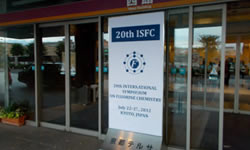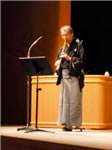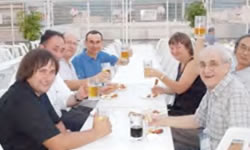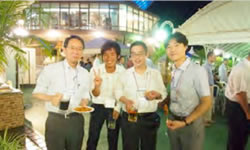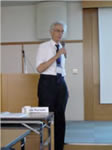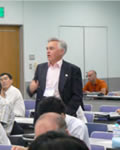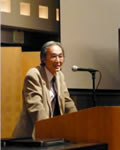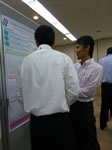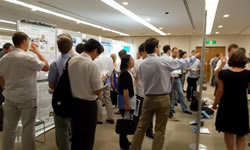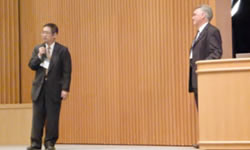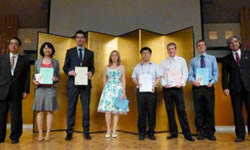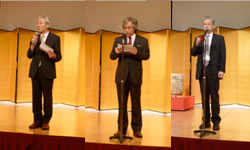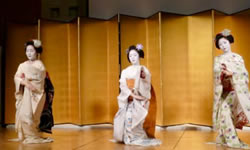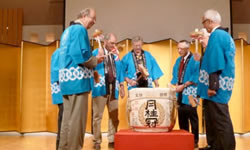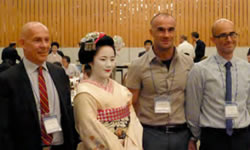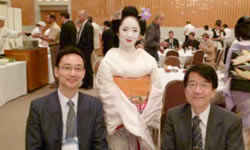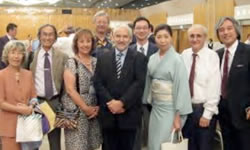Events
International Symposium on Fluorine Chemistry (ISFC)
In summer 2012, the International Symposium on Fluorine Chemistry (ISFC) was held in Kyoto, Japan, under the leadership of joint Organizing Committee chairs Rika Hagiwara and Takashi Yamazaki, marking the third time the event has been held in the country. The symposium attracted a total of 480 participants, including 176 overseas attendees representing 21 countries. The event featured presentations of research in a broad range of fields related to fluorine chemistry, including organic synthetic chemistry, advanced materials science, advanced medical science, and energy and environmental science, highlighting the high expectations that fluorine chemistry inspires. The following report appeared in Vol. 5 No. 1/2 of Fluorine, the journal’s eight issue.
Report on the 20th International Symposium on Fluorine Chemistry
Rika Hagiwara and Takashi Yamazaki, chairs of the 20th International Symposium on Fluorine Chemistry Organizing Committee
The 20th International Symposium on Fluorine Chemistry welcomed 484 participants (331 general participants, 102 students, 40 companions, and 11 guests)—a number that exceeded expectations—at Kyoto Terrsa from July 22 to 27, 2012. It was the third time for the event, which has been held once every three years since 1955, to be held in Japan, and the fact that it has returned to the country every 15 to 18 years, meaning once every five or six sessions, highlights the high regard in which Japanese fluorine chemists and their research are held internationally. In addition to being the first to be held in Japan since the launch of The Society of Fluorine Chemistry, Japan, it was a milestone event that marked the 20th time it has been held. Initial fears that attendance would suffer due to complicating factors such as the global recession and the Great East Japan Earthquake proved to be unfounded, allaying the hosts’ concerns.
The symposium began with a welcome party on July 22 where many participants clearly enjoyed being reunited with their colleagues. The opening session was held on July 23, starting with a shakuhachi flute performance by Tozan Koyama of the Shintozan School; an opening address focusing on the development of fluorine chemistry in Japan by Professor Toshio Fuchigami, chairperson of The Society of Fluorine Chemistry, Japan; and a welcome message from symposium organizer Rika Hagiwara. The event then moved on to a series of oral presentations held in three venues.
For this symposium, the organizers not only invited 27 scientists who are carrying out state-of-the-art research in a variety of fields related to fluorine chemistry in 13 countries to offer keynote addresses, but also invited 15 young speakers from 8 countries in an effort to focus on the young, up-and-coming researchers who will be responsible for pushing the field forward in the future. Ultimately, these 42 talks were complemented by a total of 133 oral presentations, including one talk that received this symposium’s Moissan Prize. The event also featured the following two mini-symposia, which earned high praise from attendees, in an experiment that marked the first time such an approach has been tried at the ISFC: “The 50th Anniversary of the Discovery of Noble-gas Reactivity” from the inorganic chemistry field and “Utilization of Metal Catalysts for Preparation of Fluorinated Compounds” from the organic chemistry field. The former introduced the effects of research into noble gas compounds over the last 50 years on inorganic fluorine chemistry and reported on the latest research trends in related fields. The latter discussed the important role of transition metal catalysts in the synthesis of fluorine compounds and described how the field is likely to undergo significant development in the future. The symposium facilitated passionate, topical discussions in the following thematic areas: 1) new reactions and new materials, 2) new functions and structures, 3) biologically active substances, 4) theory and computational chemistry, and 5) energy and environmental engineering.
A poster session was held on the evening of July 24. About half the presenters were from Japan, and the session occasioned a passionate exchange of views that included foreign participants.
The following six presenters were invited to a banquet and given certificates of commendation in recognition of their outstanding presentations: Mr. Pier Alexandre Champagne (Université Laval, Canada), Mr. Maciej Skibinski (University of St. Andrews, UK), Dr. Matthew Tredwell (University of Oxford, UK), Mr. Fei Xu (Kyoto University, Japan), Ms. Maria Ivanova (McMaster University, Canada), and Dr. Yuko Shiotani (Daikin Industries, Ltd., Japan).
The symposium’s social program consisted of a networking event held at Kyoto Tower Hotel’s rooftop beer garden. About 300 participants gathered in the evening heat and chatted about many topics that went beyond science. Many attendees remained standing around after the event, making it difficult for the organizers to vacate the venue and signaling just how much they had enjoyed the program. It was interesting to see how many foreign attendees set out for karaoke after the networking event was finished. This sort of exchange prompted Japanese attendees to think afresh about how Japanese people interact with foreigners.
No symposium sessions were held on July 25, which was left open as a day for excursions. Interested attendees and their companions went on two tours of Kyoto and one tour of Nara, traveling to famous destinations such as shrines and temples by sightseeing bus.
On July 26, a ceremony was held to present the Moissan Prize, which is awarded once every three years. This session, the award went to Dr. Alain Tressaud of the ICMCB in Bordeaux, France. Dr. Tressaud, who was accustomed to presenting the award, could hardly hide his joy at receiving it. The presentation was followed by a commemorative talk by the award recipient and then by a banquet at Hotel Granvia Kyoto that evening. About 250 attendees were present at the banquet, which began with a dance performance by apprentice geisha from Ponto-cho and a welcome message for attendees from symposium organizer Takashi Yamazaki and Professor Takeo Taguchi, chairperson of the Japan Society for the Promotion of Science’s Fluorine Chemistry 155 Committee.
Then members of the International Advisory Board opened a cask of Fushimi sake, and Professor Tsuyoshi Nakajima, chairman of The Society of Fluorine Chemistry, Japan, offered a toast. Guests chatted pleasantly in the relaxed atmosphere, and time passed quickly with the presentation of poster awards, a report on preparations for future international symposia, and a fun talk by Dr. Tressaud, the Moissan Prize winner, about his long-running relationship with Japanese culture. Professor Kenji Uneyama brought the evening to a close with some inspiring words about the future development of fluorine chemistry. It was an extremely enjoyable time that afforded the opportunity to speak with many attendees.
At a Steering Committee Meeting held during the symposia, the organizer reported on preparations for the upcoming 17th European Symposium on Fluorine Chemistry (to be held in Paris, France, in 2013), the 21st International Symposium on Fluorine Chemistry (to be held in Como, Italy, in 2015), and the 18th European Symposium on Fluorine Chemistry (to be held in Kiev, Ukraine, in 2016). In addition, Oxford, England, was selected as the location for the 22nd International Symposium on Fluorine Chemistry (to be held in 2018), while Poland was selected as the location of the 19th European Symposium on Fluorine Chemistry (to be held in 2019).
We hope that many Japanese will attend these events. At the farewell party on the last day of the symposium, numerous attendees said their farewells to friends and promised to meet again at the next International Symposium or European Symposium.
In closing, we would like to thank the members of the Organizing Committee who worked to make the event a success, members of the 155th Committee of the Japan Society for the Promotion of Science, members of other support organizations and supporting companies, and everyone who attended the symposium.
